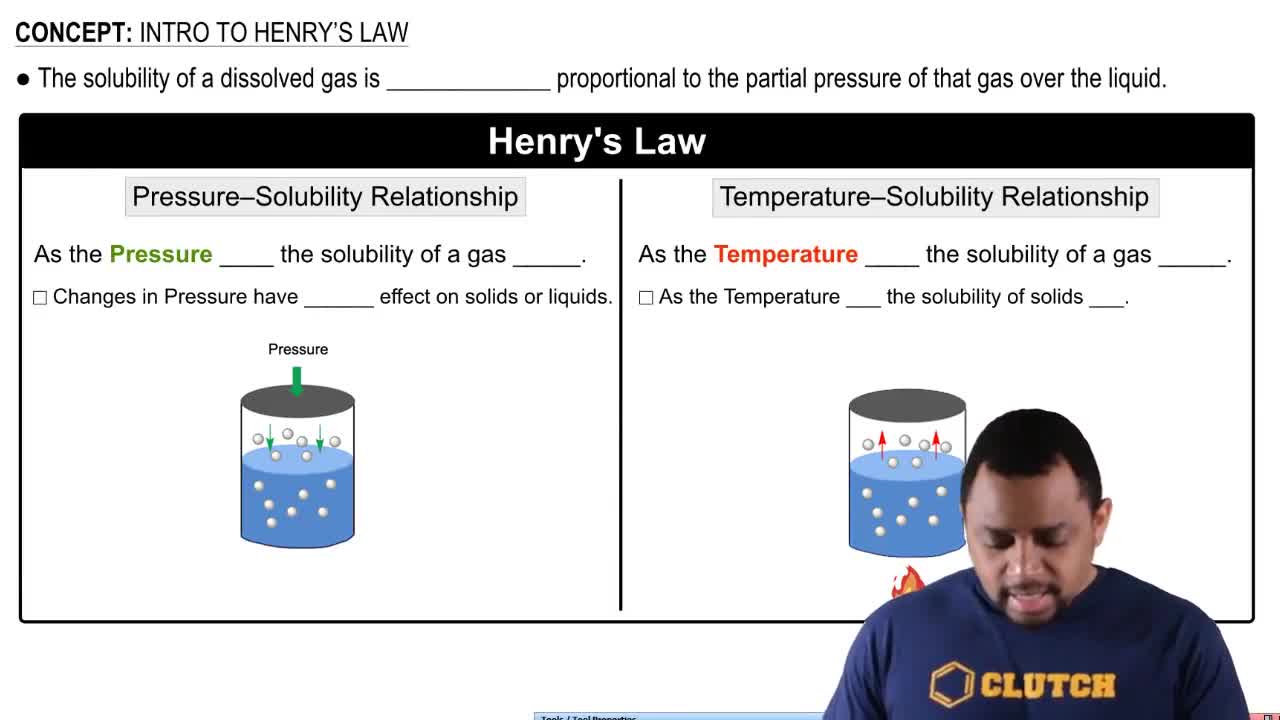Pick an appropriate solvent from Table 13.3 to dissolve each substance. State the kind of intermolecular forces that would occur between the solute and solvent in each case. b. sodium chloride (ionic)
Ch.14 - Solutions

Chapter 14, Problem 33
For each compound, would you expect greater solubility in water or in hexane? Indicate the kinds of intermolecular forces that occur between the solute and the solvent in which the molecule is most soluble. a. glucose
 Verified step by step guidance
Verified step by step guidance1
Identify the polarity of glucose and hexane. Glucose is a polar molecule due to its numerous hydroxyl (OH) groups that can form hydrogen bonds. Hexane, on the other hand, is a nonpolar hydrocarbon with only London dispersion forces.
Consider the solubility principle 'like dissolves like'. Polar solutes tend to dissolve better in polar solvents, and nonpolar solutes dissolve better in nonpolar solvents.
Predict the solubility of glucose based on the principle from step 2. Since glucose is polar, it will be more soluble in water, which is also a polar solvent, compared to hexane, which is nonpolar.
Identify the intermolecular forces between glucose and water when glucose is dissolved. The primary intermolecular forces would be hydrogen bonding between the hydroxyl groups of glucose and the water molecules.
Conclude that glucose is more soluble in water due to the strong hydrogen bonds that can form with water, compared to the weak London dispersion forces that would occur between glucose and hexane.

Verified video answer for a similar problem:
This video solution was recommended by our tutors as helpful for the problem above.
Video duration:
1mWas this helpful?
Key Concepts
Here are the essential concepts you must grasp in order to answer the question correctly.
Polarity of Molecules
Polarity refers to the distribution of electrical charge over the atoms in a molecule. Polar molecules, like glucose, have regions of partial positive and negative charge due to differences in electronegativity between atoms. This property influences solubility, as polar substances tend to dissolve well in polar solvents like water, while nonpolar substances dissolve better in nonpolar solvents like hexane.
Recommended video:
Guided course

Molecular Polarity
Intermolecular Forces
Intermolecular forces are the forces of attraction or repulsion between neighboring particles (atoms, molecules, or ions). In the case of glucose in water, hydrogen bonding is a significant intermolecular force, as glucose can form hydrogen bonds with water molecules. Understanding these forces helps predict solubility, as stronger interactions between solute and solvent lead to greater solubility.
Recommended video:
Guided course

Intermolecular vs Intramolecular Forces
Like Dissolves Like
The principle of 'like dissolves like' states that polar solvents dissolve polar solutes, and nonpolar solvents dissolve nonpolar solutes. This concept is crucial for predicting solubility; since glucose is a polar molecule, it is expected to be more soluble in water (a polar solvent) than in hexane (a nonpolar solvent). This principle helps in understanding the behavior of different compounds in various solvents.
Recommended video:
Guided course

Henry's Law Solubility
Related Practice
Textbook Question
Textbook Question
Which molecule would you expect to be more soluble in water: CH3CH2CH2OH or HOCH2CH2CH2OH?
1
views
Textbook Question
For each compound, would you expect greater solubility in water or in hexane? Indicate the kinds of intermolecular forces that would occur between the solute and the solvent in which the molecule is most soluble. d. ethylene glycol
Textbook Question
When lithium iodide (LiI) is dissolved in water, the solution becomes hotter. a. Is the dissolution of lithium iodide endothermic or exothermic?
Textbook Question
When lithium iodide (LiI) is dissolved in water, the solution becomes hotter. b. What can you conclude about the relative magnitudes of the lattice energy of lithium iodide and its heat of hydration?
